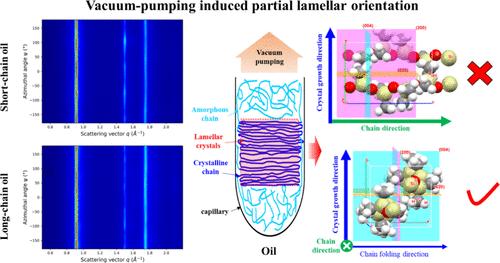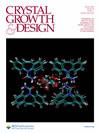Vacuum-Pumping Induced Crystallographic Anisotropy of Poly(dimethylsiloxane) Oil under Capillary Confinement
IF 3.2
2区 化学
Q2 CHEMISTRY, MULTIDISCIPLINARY
引用次数: 0
Abstract
Investigating the low-temperature crystallization behavior of liquid polysiloxanes poses a significant challenge. To address this issue, a custom low-temperature chamber with specialized sample holders was meticulously constructed and integrated with a laboratory X-ray diffraction apparatus, enabling time-resolved wide-angle X-ray diffraction (WAXD) measurements of linear poly(dimethylsiloxane) (PDMS) oil and cross-linked PDMS film during cooling and heating. Under vacuum pumping and capillary confinement, the linear silanol-terminated PDMS oil demonstrates significant crystalline orientation at low temperatures when the crystalline index surpasses 10%, with the recorded 2D diffraction patterns showing heterogeneous azimuthal intensity distributions. The presence of crystallographic anisotropy is strongly influenced by the experimental vacuum pumping rather than the millimeter-scale capillary confinement. Unlike the strain-induced alignment of crystalline planes observed in stretched PDMS film, the vacuum-pumping-induced crystallographic anisotropy in linear PDMS oil measured within a capillary only results in a minimal or partial lamellar orientation. This alignment will cause crystalline chain segments to pack parallel to the incident X-ray beam direction and fold within the a-c plane. These findings are expected to enhance low-temperature X-ray analysis techniques for liquid samples and facilitate future crystallographic investigations of polysiloxane materials.

毛细管约束下真空泵诱导的聚二甲基硅氧烷油结晶各向异性
研究液态聚硅氧烷的低温结晶行为是一项重大挑战。为了解决这个问题,我们精心制造了一个带有专用样品架的定制低温室,并将其与实验室 X 射线衍射仪器集成在一起,从而能够在冷却和加热过程中对线性聚二甲基硅氧烷(PDMS)油和交联 PDMS 薄膜进行时间分辨广角 X 射线衍射(WAXD)测量。在真空抽气和毛细管限制条件下,当结晶指数超过 10% 时,线性硅烷醇封端 PDMS 油在低温下显示出明显的结晶取向,记录的二维衍射图样显示出异质的方位角强度分布。晶体学各向异性的存在受到实验真空抽气而非毫米级毛细管约束的强烈影响。与在拉伸的 PDMS 薄膜中观察到的应变诱导的结晶平面排列不同,在毛细管中测量的线性 PDMS 油中,真空泵诱导的结晶各向异性只会导致极小或部分的片状取向。这种排列会导致结晶链段平行于入射 X 射线束方向堆积,并在 a-c 平面内折叠。这些发现有望提高液体样品的低温 X 射线分析技术,并促进未来对聚硅氧烷材料的晶体学研究。
本文章由计算机程序翻译,如有差异,请以英文原文为准。
求助全文
约1分钟内获得全文
求助全文
来源期刊

Crystal Growth & Design
化学-材料科学:综合
CiteScore
6.30
自引率
10.50%
发文量
650
审稿时长
1.9 months
期刊介绍:
The aim of Crystal Growth & Design is to stimulate crossfertilization of knowledge among scientists and engineers working in the fields of crystal growth, crystal engineering, and the industrial application of crystalline materials.
Crystal Growth & Design publishes theoretical and experimental studies of the physical, chemical, and biological phenomena and processes related to the design, growth, and application of crystalline materials. Synergistic approaches originating from different disciplines and technologies and integrating the fields of crystal growth, crystal engineering, intermolecular interactions, and industrial application are encouraged.
 求助内容:
求助内容: 应助结果提醒方式:
应助结果提醒方式:


